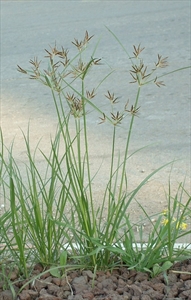- Widespread. Asia, Africa, North, South and Central America, Caribbean, Europe, Oceania. In most Pacific countries.
- Invasive, grows very rapidly in a wide variety of environments, irrespective of soil types. Problematic in field crops, orchards, vineyards, pastures, gardens, fallows, natural and waste areas, footpaths, roadsides, banks of waterways, produces underground tubers that regenerate plants, and is tolerant of many herbicides.
- Plants 20-60 cm tall. Leaves, narrow, up to 20 cm long, at base of plants. Stems, underground, producing small tubers in chains, white and fleshy at first, later brown and wiry. Buds on the tubers form new plants. Flower stems, smooth, glossy, triangular in cross-section, with 3-8 branches of different lengths and leaf-like structures beneath; each branch bears several reddish-brown 'spikelets' with flowers. The fruits are 3-angled, brown or black, with a single seed inside. Germination very low, but many seed produced.
- Spread: underground stems; by cultivation and machinery; seed (probability low); flood waters; as a specialist food.
- Biosecurity: high risk of introduction; one of the worst 10 weeds in Fiji, French Polynesia, Guam, New Caledonia, PNG, Solomon Islands, Tonga. On Global Invasive Species Database of alien invasive species (IUCN, 2020). Biocontrol: a moth, Bactra species, and a mycoherbicide, using Dactylaria higginsii.
- Cultural control: hand weed; shade; plough and disc; polyethylene mulch; vehicle hygiene to remove tubers and seed; ducks and/or chickens will eat the tubers.
- Chemical control: in Australia: glyphosate; 2,4-D; and the selective herbicide, halosulfuron-methyl. In Fiji, MCPA.







